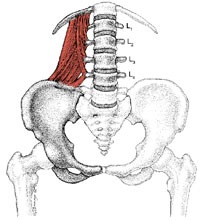Anatomy Angel: Quadratus Lumborum
December 30, 2014 by Kathy Dooley
The quadratus lumborum (QL) is a glorious muscle of the posterior abdominal wall.
This muscle attaches to transverse processes of vertebrae L1-L4, anchoring itself inferiorly to the iliolumbar ligament and iliac crest.
These attachments place the QL in perfect position to laterally stabilize the lumbar spine on each side, much like the cable stays of a bridge, like the one below.
The QL also anchors itself below rib 12, a floating rib that attaches to the T12 vertebrae. It also attaches to the thoracic diaphragm, via the lateral arcuate ligament.
So, the QL also helps you breathe.
It’s no accident that this key spinal stabilizer is a breathing muscle.
Every breath you take can help QL either stabilize the spine – or not.
Many people with flexion intolerance have chronically tight and painful QL muscles.
It’s tight because you’ve lost spinal stability in flexion. Stretch the QL without providing stability, and it will backfire by making itself even tighter.
If erector spinae or multifidii aren’t more centrally supporting the spine, then QL will be your deep, last ditch effort to keep you extended and upright.
The opposite is true in extension intolerance. The QL is primarily a tonic back extensor and often a pain generator in those who tend to extend too much through the lumbar spine.
The QL is covered on its anterior and posterior surfaces with thoracolumbar fascia (anterior and middle layers, respectively). In fact, it shares fascia with the kidney, the organ that sits directly on it’s anterior surface. This fascia connects QL to intrinsic and extrinsic abdominal (core) musculature.
The QL also can hike the pelvis, if the rib cage is fixed. If gluteal muscles aren’t stabilizing the hip in the coronal plane, QL will again take over.
The L1 ventral ramus passes between the QL and its anterior fascia. Hypertonic QLs can irritate this nerve, causing pain or even numbness into the areas above and around the pubic symphysis.
This painful muscle is blamed for “bad backs” all over the world.
But this muscle gets tight in an effort to keep your spine stable.
Remember those cable stays before you go blindly stretching QL.
The often overworked QLs could use your help.
Don’t just stretch and rub on sore QLs.
Teach the abdominal and hip musculature to share the load.
If your spine is laterally flexed with a hip hike, your gluteals may not be doing their job.
If you have spinal flexion or extension pain, your core musculature may not be properly sequencing.
Get assessed and corrected to see if QL may need a load share.
As always it’s your call.
– Dr. Kathy Dooley




